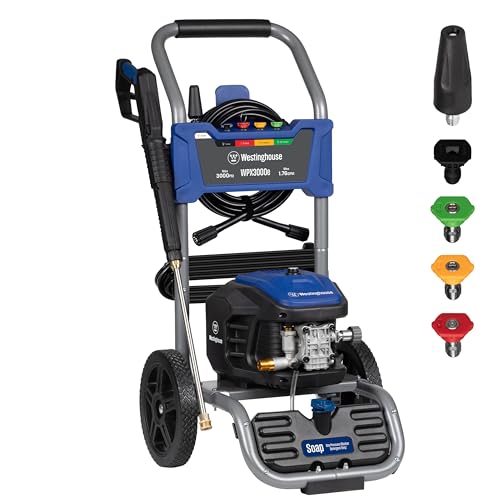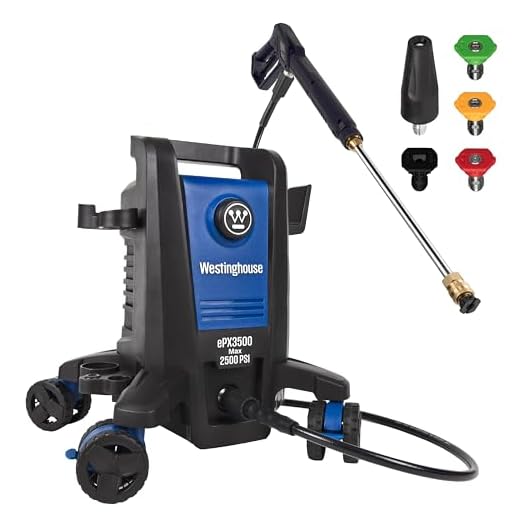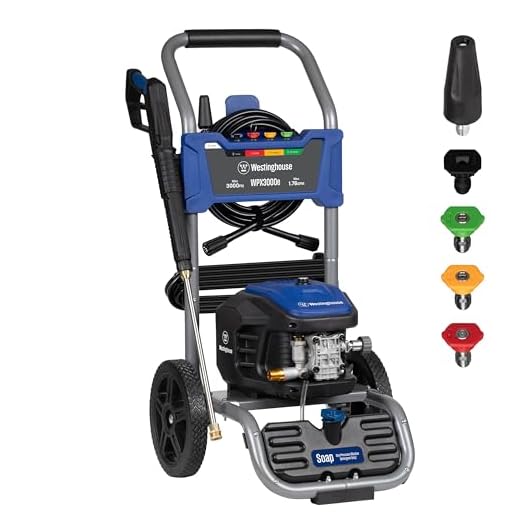Blog
How To Use A Pressure Washer To Remove Paint

When it comes to removing paint from various surfaces, a pressure washer can be an incredibly effective tool. Whether you’re looking to remove old paint from a wooden fence, a metal surface, or even a concrete wall, a pressure washer can help you get the job done quickly and efficiently.
Before you start using a pressure washer to remove paint, it’s important to take a few precautions. Make sure to wear safety goggles and gloves to protect yourself from any paint chips that may fly off during the process. Additionally, it’s advisable to cover nearby plants, furniture, and other objects that you don’t want to get damaged by the paint removal process.
Once you’ve taken the necessary safety precautions, it’s time to start using your pressure washer. First, select the appropriate nozzle for the job. A narrow spray pattern will give you more concentrated power, which is ideal for stubborn, thick layers of paint. On the other hand, a wider spray pattern is better for lighter layers or more delicate surfaces.
Before you start blasting away at the paint, it’s a good idea to test the pressure washer on a small, inconspicuous area to determine the best distance and angle to hold the nozzle. Once you have a sense of the optimal distance and angle, you can begin removing the paint by moving the nozzle back and forth across the surface in a steady, controlled manner.
What is a Pressure Washer?
A pressure washer is a mechanical device that uses a high-pressure stream of water to remove dirt, grime, mold, or paint from surfaces. It consists of a motor, a pump, and a spray wand or nozzle. The motor powers the pump, which pressurizes the water and forces it through the wand or nozzle at a high velocity.
The pressure washer comes with various types of nozzles that produce different spray patterns and pressures. The nozzle selection determines the intensity of the water stream, allowing the user to adjust the pressure according to the task at hand. Some pressure washers also allow for the addition of detergent or cleaning solutions to help with the cleaning process.
Pressure washers are commonly used for a range of cleaning applications, including removing dirt and stains from vehicles, decks, sidewalks, and buildings. They are particularly effective at removing loose paint from surfaces, making them a valuable tool for paint removal projects.
How does a Pressure Washer work?
The pressure washer works by forcing water through a small opening, which creates a high-pressure stream. The pump pressurizes the water by compressing it, which increases its kinetic energy. When the water is released through the nozzle, the energy is transferred to the water particles, creating a powerful water jet that can dislodge dirt, grime, and paint.
The different types of nozzles allow the pressure washer to deliver varying spray patterns, ranging from a narrow, high-pressure stream to a wide, low-pressure spray. This versatility makes pressure washers suitable for different surfaces and cleaning tasks.
Precautions when using a Pressure Washer:
While pressure washers are effective tools for paint removal, it’s essential to take proper precautions when using them:
- Wear protective clothing: Always wear goggles, gloves, and appropriate clothing to protect yourself from the powerful spray and any debris that might be dislodged.
- Adjust the pressure: Use the appropriate nozzle and adjust the pressure to a level that will remove the paint without damaging the underlying surface.
- Keep a safe distance: Stand approximately 2 feet away from the surface and maintain a consistent distance to avoid causing damage.
- Work in a well-ventilated area: Pressure washers release fumes and cleaning chemicals, so it’s important to work in a well-ventilated area to avoid inhalation.
- Read the instructions: Always read and follow the manufacturer’s instructions for operating the pressure washer to ensure safe and proper use.
Why Use a Pressure Washer to Remove Paint?
When it comes to removing paint from various surfaces, a pressure washer can be a highly effective tool. Not only can it save you time and effort compared to traditional methods, but it can also provide better results.
1. Fast and Efficient: Pressure washers are designed to deliver a powerful jet of water at high pressure, allowing them to quickly and efficiently remove paint. This makes them an ideal choice for large surfaces or projects with multiple layers of paint.
2. Versatility: Pressure washers can be used on a wide range of surfaces, including wood, concrete, metal, and even delicate materials like glass. This versatility allows you to tackle paint removal on different areas of your home or outdoor spaces.
Benefits of Using a Pressure Washer
1. No Harsh Chemicals: One of the major advantages of using a pressure washer is that it eliminates the need for harsh chemical paint strippers. This not only makes the process safer for you and the environment, but it also reduces the cost of materials.
2. Prevents Damage to Surfaces: Pressure washers have adjustable settings, allowing you to control the pressure and avoid damaging the surface under the paint. This is especially important for delicate materials or surfaces that may be prone to scratches or dents.
Precautions to Take
1. Eye and Ear Protection: Always wear safety goggles and ear protection when operating a pressure washer, as the high pressure can cause water and debris to spray back.
2. Test on a Small Area: Before starting, test the pressure washer on a small, inconspicuous area to ensure it doesn’t damage or etch the surface.
3. Keep a Safe Distance: Maintain a safe distance between the pressure washer nozzle and the surface to avoid damage and injuries. Follow the manufacturer’s guidelines for the ideal distance.
Overall, using a pressure washer to remove paint is a convenient and efficient method that yields great results without the need for harsh chemicals. Just remember to take proper precautions and test on a small area before tackling larger projects.
Preparations
Before using a pressure washer to remove paint, it’s important to take the necessary preparations to ensure safety and efficiency. Here are the steps you should follow:
- Choose the right pressure washer: Select a pressure washer with enough power to remove paint effectively. Higher pressure washers are usually more efficient for this task. Make sure the pressure washer has a nozzle suitable for paint removal.
- Wear protective clothing: Protect yourself by wearing appropriate clothing, including goggles, gloves, and long-sleeved shirts. This will help prevent any paint chips or debris from harming your skin or eyes.
- Cover nearby objects: Cover any nearby plants, furniture, or other objects that you don’t want to get paint chips or water on. Use plastic sheets or tarps to protect these items.
- Prepare the work area: Clear the surrounding area of any obstacles or debris. This will ensure easy access and prevent any accidents while using the pressure washer.
- Remove loose paint: Use a scraper or wire brush to remove loose paint before using the pressure washer. This will make the pressure washing process more effective and prevent paint chips from flying off.
- Test the pressure: Before starting on the main surface, test the pressure washer on a small, inconspicuous area to ensure that it doesn’t damage the underlying surface. Adjust the pressure if necessary.
By following these preparations, you will create a safe and efficient environment for removing paint using a pressure washer. These steps will help you achieve the best results while minimizing any potential risks or damages. Keep in mind that safety should always be your top priority when using power tools.
Gather the Necessary Materials
Before you start using a pressure washer to remove paint, you’ll need to gather a few materials to ensure a successful project. Here’s a list of the essential items:
- Safety goggles or glasses- These will protect your eyes from any debris or paint chips that may fly off during the pressure washing process.
- Protective clothing- It’s important to wear long sleeves, pants, and closed-toe shoes to protect your skin from any potential hazards.
- Pressure washer- Make sure you have a pressure washer with enough power and a suitable attachment for paint removal. Different pressure washers have different levels of pressure, so choose one that suits your needs.
- Paint scraper or brush- Use a scraper or brush to loosen any loose or peeling paint before using the pressure washer. This will help make the pressure washing process more effective.
- Water source- You’ll need a water source to connect your pressure washer to. Make sure you have access to a garden hose or other water supply.
- Drop cloths or plastic sheeting- To protect any surrounding areas or objects from paint chips or water splatter, cover them with drop cloths or plastic sheeting.
- Protective covering for plants and shrubs- If you have any plants or shrubs near the area you’ll be pressure washing, cover them with plastic sheeting or tarp to prevent them from getting damaged.
- Soap or detergent- Depending on the type of paint you’re removing, you may need to use a soap or detergent specifically designed for paint removal. Check the manufacturer’s recommendations.
- Broom or brush- Have a broom or brush on hand to sweep away any loose paint chips or debris from the surface you’ll be pressure washing.
Having all of these materials ready before starting the paint removal process will ensure that you have everything you need for a successful and efficient project.
Protect the Surrounding Area
Before you start using a pressure washer to remove paint, it’s essential to protect the surrounding area to prevent damage. Paint chips and debris can be propelled by the high-pressure water stream, potentially causing harm to nearby objects or surfaces.
Here are some steps to protect the surrounding area:
- Cover nearby objects: Use plastic sheets or tarps to cover any items that could be damaged by overspray or paint chips. This includes vehicles, furniture, plants, and delicate surfaces.
- Tape off surfaces: Use painter’s tape to create a boundary between the surface you want to clean and surrounding surfaces that you want to keep paint-free. This will help minimize accidental paint removal.
- Seal off openings: Close windows, doors, and any other openings that could allow water or debris to enter your home or other buildings nearby.
- Wear protective gear: When operating a pressure washer, always wear protective gear such as safety glasses, gloves, and non-slip footwear to ensure your safety.
By taking these precautions, you can effectively remove paint without causing damage to the surrounding area. Remember, safety should always be your top priority when using a pressure washer.
Using the Pressure Washer
Once you have prepared the area and yourself for paint removal, it’s time to start using the pressure washer. Follow these steps to ensure effective and safe paint removal:
1. Adjust the pressure
Before you begin, adjust the pressure on your pressure washer to a level suitable for the type of surface you are working on. For delicate surfaces or thin layers of paint, use a lower pressure setting to avoid damaging the underlying material. For heavy-duty paint removal, you may need to use a higher pressure setting.
2. Test a small area
Before starting the full paint removal process, it’s always a good idea to test the pressure washer on a small, inconspicuous area. This will allow you to gauge the effectiveness without risking damage to the entire surface.
3. Maintain the correct distance
When using the pressure washer, it’s important to maintain the correct distance between the nozzle and the surface. Holding the nozzle too close can cause damage, while holding it too far away may result in ineffective paint removal. Generally, a distance of about 12-18 inches from the surface is recommended.
Note: Always refer to the manufacturer’s instructions for specific guidance on distance and pressure settings for your pressure washer model.
4. Use even and overlapping strokes
When applying the pressure washer to the painted surface, use even and overlapping strokes to ensure thorough paint removal. Avoid lingering in one spot for too long, as it may result in uneven paint removal or surface damage.
5. Work in sections
For large areas, it’s best to work in sections to ensure complete and consistent paint removal. Start at one end of the surface and work your way across, overlapping each section slightly to prevent missed spots.
Remember to take breaks and hydrate during longer paint removal sessions to avoid fatigue and stay safe.
By following these steps and using your pressure washer correctly, you can effectively remove paint from various surfaces and achieve a clean and ready-to-paint surface.
Adjust the Pressure
When using a pressure washer to remove paint, it’s important to adjust the pressure setting correctly. Setting the pressure too high can damage the surface you’re working on, while setting it too low may not effectively remove the paint. Here are some guidelines to help you adjust the pressure:
1. Consult the manufacturer’s instructions
Before you begin using the pressure washer, read the manufacturer’s instructions thoroughly. They should provide specific guidance on adjusting the pressure for different surfaces and paint types.
2. Start with a lower pressure
If you’re unsure about the appropriate pressure for a particular surface, start with a lower setting. This will allow you to assess how effectively the paint is being removed without causing any damage. Gradually increase the pressure if necessary.
Keep in mind that different surfaces and types of paint may require different pressure settings. For example, a more delicate surface may require a lower pressure, while a tougher surface may need a higher pressure to remove the paint effectively.
It’s also a good idea to test the pressure washer on a small, inconspicuous area of the surface to ensure that the pressure setting is appropriate.
3. Use the appropriate nozzle
The nozzle you use can also affect the pressure of the water coming out of the pressure washer. Different nozzles produce different spray patterns and pressures. Consult the manufacturer’s instructions or experiment with different nozzles to find the one that works best for your specific project.
Some pressure washers will have adjustable nozzles that allow you to vary the pressure by rotating the nozzle. This can be helpful when working on surfaces that require different pressure settings.
Remember to always wear protective gear, such as safety goggles and gloves, when using a pressure washer. It’s also important to follow all safety precautions outlined in the manufacturer’s instructions.
| Pressure Washer Pressure Settings | Recommended Surfaces |
|---|---|
| Low (500-1000 PSI) | Wood, siding, stucco |
| Medium (1000-2000 PSI) | Concrete, brick |
| High (2000-3000 PSI) | Metal, tough surfaces |
Start with a Test Area
Before using a pressure washer to remove paint, it is important to start with a test area to ensure that the process will be effective without damaging the underlying surface. Select a small, inconspicuous area to test the pressure washer’s power and the effect it has on the paint.
Create a table with two columns to document your findings. In the first column, record the pressure washer settings and nozzle type used for the test area. In the second column, record the results of the test, including how much paint was removed and any damage to the surface.
| Pressure Washer Settings and Nozzle Type | Test Area Results |
|---|---|
| Pressure: 2000 PSI Nozzle Type: 15-degree |
Paint removal: Partial Surface damage: None |
| Pressure: 2500 PSI Nozzle Type: 25-degree |
Paint removal: Complete Surface damage: Minimal |
By starting with a test area, you can adjust the pressure washer settings and nozzle type as needed to achieve the desired results while minimizing any potential damage to the surface. It is important to remember that different surfaces and types of paint may require different settings, so it may be necessary to repeat the test on multiple areas before starting the full paint removal process.
Questions and answers
What is a pressure washer?
A pressure washer is a high-power mechanical sprayer that uses water or a combination of water and detergent to remove dirt, grime, mold, and paint from surfaces.
What type of pressure washer is best for removing paint?
A pressure washer with a high PSI (pounds per square inch) rating and a high GPM (gallons per minute) rating is best for removing paint. Look for a pressure washer with at least 3000 PSI and 2.5 GPM.
Can a pressure washer remove all types of paint?
A pressure washer can remove most types of paint, including oil-based and latex paint. However, there may be certain types of paint, such as epoxy or enamel, that may be more difficult to remove and may require additional methods.
Do I need special equipment to use a pressure washer to remove paint?
In addition to a pressure washer, you may need a paint scraper or a pressure washer attachment specifically designed for paint removal. You may also need safety equipment such as goggles and gloves to protect yourself from flying debris.
Are there any safety precautions I should take when using a pressure washer to remove paint?
Yes, it is important to wear goggles, gloves, and protective clothing to protect yourself from debris and chemicals. It is also important to use the pressure washer in a well-ventilated area and to follow the manufacturer’s guidelines for proper use and maintenance of the equipment.
Recent Posts
-
How To Connect Soap To Honda Pressure Washer
June 28, 2024 -
A To Z Pressure Washing Scam
June 27, 2024 -
How To Pressure Wash Your Home With A Garden Hose
June 27, 2024 -
Where Can I Buy Honda Pressure Washer Parts
June 25, 2024







